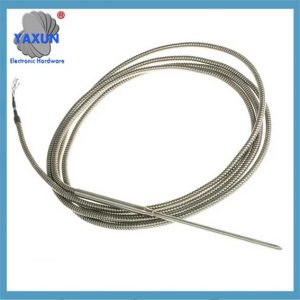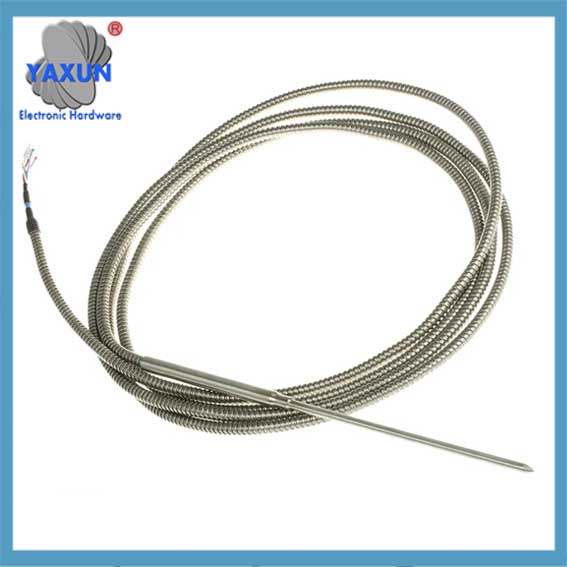Produktkategorien
- Thermischer Schutzschalter 20
- Sicherungskastenhalter 36
- Temperatursensor 67
- Thermischer schalter 64
- Autosicherung 19
- Sicherungen festschrauben 7
- Thermosicherung 32
- oberflächenmontierte Sicherungen 12
- Thermistor 22
- Sicherungshalter für Leiterplattenmontage 27
- Kabelbaum 6
- Flachsicherungshalter 17
- Thermostat 46
- Elektro-Sicherung 14
Produkt Tags
Energiespeicher CCS PT100 / PT1000 -Sensor & Lösung für Kabelbaugruppe
PT100 und PT1000 sind das am häufigsten verwendete RTD -Sensorenkabel. Obwohl ähnlich, Ihre unterschiedlichen Nennwiderstände bestimmen, welche Anwendungen sie entsprechen werden. Erhältlich in zwei Versionen: als dünner Filmsensor und als Drahtsensor, die sich im zulässigen Messstrom und im Betriebstemperaturbereich unterscheiden.
Advantages of Energy Storage CCS PT100/PT1000 Sensor Cable:
Harness Cable: stable signal transmission;
Struktur: support design changes;
After-sales: easy to repair;
Temperature acquisition: excellent moisture resistance.
 China Custom PT100 Temperatursensor, 2 Draht, -40 Zu 800 Sie c |
 PT100 RTD Sensor, 5mm Dia, 150mm Long, 2 X 3 Draht, Probe, Class A B +250°C Max |
 Thermoelement PT100 Temperatursensor -Sonden -Gewinde mit Edelstahlmaterial für den industriellen und häuslichen Gebrauch bei der Heizung |
Product parameters:
1. Isolation board: fire retardant. Material is PC+ABS or PA66, usw.
2. Collection end shell: pure nickel shell, thin shell wall, fast heat conduction, good welding penetration effect.
3. 1060 aluminum bar: light structure, low impedance, fast heat dissipation.
4. Connection and fixation: laser welding, firm and beautiful, high degree of automation.
5. High sensitivity and rapid response (resistance value and B value accuracy can reach ±1% respectively).
6. The finished product withstands voltage up to 4200VDC.
7. Built-in high-reliability single-ended resistor, equipped with patented internal structure process, life up to 20 Jahre.
For the bracket, you can choose injection molding or blister isolation board + wire trough;
For the collection component, you can choose wire harness, FPC, Leiterplatte, FFC;
For the temperature collection line, you can choose epoxy head, OT terminal, nickel terminal (all including NTC);
For the connection method, you can choose glue, screw, ultrasonic welding or laser welding.
Application scenarios:
Industrial and commercial energy storage, Kommunikationsenergiespeicher, household energy storage, portable energy storage
Design of Pt100/Pt1000 sensor
In industrial use, Pt100/Pt1000 sensor usually exist as a measuring insert which is installed in a connection head and an appropriate protective fitting. The electrical connection is made within the connection head. As a measuring insert the easily replaceable unit of the thermometer is referred to, which consists of a conduit or cable from suitable material and whose sensitive end contains one or more Pt100/Pt1000 platinum sensor. Protected by a thermowell, a temperature measuring point can be constructed that enables the exchange of the thermometer in the event of repair or calibration without interfering with the process.
A further industrial design of Pt100/Pt1000 sensor are those known as cable probes. In these cases, the connection cable is assembled directly with the metallic part of the thermometer.
Applications for resistance thermometers with Pt100 or Pt1000 sensors
Whether a Pt100 or a Pt1000 , Pt500 sensor is used depends on the respective application. In the process industry, Pt100 sensors represent the most frequently used and the most common type of resistance sensor worldwide. Jedoch, there are applications where the use of Pt1000 Pt500 sensors makes sense. Thus, Zum Beispiel, with a two-wire connection, the use of Pt1000 , Pt500 sensors has the advantage over Pt100 sensors, since here the influence of the cable length in the overall measuring error is only a fraction of that of Pt100 sensors. Also with battery-operated thermometers the higher nominal resistance of the Pt1000 , Pt500 sensor has a positive effect on the energy balance of the instrument. For this reason, batteries have a longer service life, meaning longer maintenance intervals and with that reduced service costs. When using Pt1000 , Pt500 sensors, it should be ensured that the downstream evaluation electronics can actually process the Pt1000 signal. In modern temperature controllers or display instruments this is usually the case, as the sensor input can be freely configured.
Kontaktiere uns
Warten auf Ihre E-Mail, Wir werden Ihnen innerhalb von 24 Stunden antworten 12 Stunden mit wertvollen Informationen, die Sie brauchten.
 English
English العربية
العربية Български
Български 粤语
粤语 中文(简体)
中文(简体) 中文(漢字)
中文(漢字) Nederlands
Nederlands Suomi
Suomi Français
Français Deutsch
Deutsch Ελληνικά
Ελληνικά Magyar
Magyar Italiano
Italiano 日本語
日本語 한국어
한국어 Polski
Polski Português
Português Română
Română Русский
Русский Slovenščina
Slovenščina Español
Español Svenska
Svenska ภาษาไทย
ภาษาไทย Türkçe
Türkçe Tiếng Việt
Tiếng Việt



